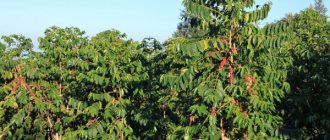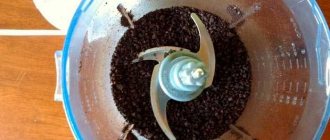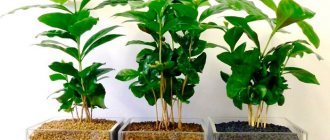Indoor trees are very popular in modern decorative floristry.
Compared to regular flowers, they require significantly less care. At the same time, a small tree looks impressive in almost any room. Dear readers!
For you, we have created communities on social networks in which useful articles and interesting ideas are published several times a day! Subscribe and receive useful content in a convenient format! In today's article we will talk about one of the most popular indoor woody plants, the coffee tree.
Botanical description and homeland of the plant
The plant is part of the Rubiaceae family. The tree's homeland is ancient Abyssinia (modern Ethiopia). Now the coffee tree can be found even in the wild in South America, Asia, and other areas of Africa.
Indoor varieties are widespread everywhere.
At home, coffee is a low bushy tree that grows mainly in several thin trunks. The plant does not branch much. The process of formation of additional shoots usually begins only in the 2nd year. Coffee has large oval leaves with a pointed tip. The surface of the leaf blade is slightly convex with clearly visible veins. The color is green.
Coffee blossoms and bears fruit. The inflorescence is umbellate and consists of small white flowers. After flowering, a fruit is formed, which turns red when ripe. The berry is covered with a small crust, inside there is sweet and sour pulp and a couple of seeds-grains, from which the famous drink is prepared.
Transplantation and formation of a bush
Caring for a coffee tree at home is impossible without regular replanting. The young plant changes its place of residence annually. The tree is moved into a pot that is 5–6 cm larger in diameter than the previous one.
An adult plant over 3 years old requires replanting less often. The procedure is usually performed no more than once every 2–3 years.
It is important to choose the right moment. Transplantation is not done during flowering or fruiting. After harvesting, the right time comes for this procedure.
Coffee trees are replanted using the transshipment method. The plant is moved to a new location along with the existing earthen lump on the roots. Coffee trees are usually planted in groups. As it grows, a lush bush is formed, the crown of which must be decorated. To do this, pruning is done at the end of winter or beginning of spring.
In addition, height restrictions may be required. To do this, pinch the top or perform a constriction. After this, the plant acquires a spherical shape, the crown becomes thick and lush.
Caring for your coffee tree after purchase
Before you go to the store and buy yourself a new green pet, you should think about where to put it. Remember that coffee is a tree, and although it will not grow to several meters at home, it still needs space.
So, you bought yourself a coffee seedling. First of all, he must be quarantined. This is necessary so that the plant gets used to the new conditions. Also during this time you can find out whether the plant is sick and whether pests live on it.
In addition to quarantine, the coffee tree can be replanted. A transplant is required in the following cases:
- Several coffee cuttings sit in one container;
- The pot is too low quality;
- The soil mixture is a nutrient substrate, not ordinary soil.
ON A NOTE. Don't worry if all the leaves have fallen off the tree after replanting. This is due to the fact that all the plants in stores are “overfed”. Very soon the coffee will return to normal.
Transplantation and propagation of Arabica Coffee flowers
Without changing the pot, it is impossible to grow a healthy, large and fruit-bearing tree. It is required every spring for young representatives. The new container is selected slightly larger than the previous one. For the adult “generation” such a need appears every 3 years. Over the next 2 years, the top layer of soil is replaced.
The Arabica coffee flower is propagated using two methods.
Cuttings
This is the most effective and convenient way. They are purchased at special flower shops. Before planting, they are kept for 3 hours in a special solution, which is purchased in the same place. After this, you can root in azalea substrate.
No temporary container is needed. Planted immediately into a permanent location. It takes about 2 months for the roots to form.
Seeds
The greatest difficulty is finding high-quality planting material. Store-bought products have most likely already lost their viability. It is better to find the owners of the tree and ask them for grain from their pet. The soil is prepared in advance. The seeds are soaked in a weak solution of potassium permanganate and watered with it at the end. Deepen 0.5-1 cm into the hole. For rapid emergence of seedlings, create greenhouse conditions and cover with a jar.
Growing conditions
In general, the coffee tree does not pose impossible tasks for the grower. The plant needs quite ordinary care and growing conditions, but with its own characteristics.
Temperature
Coffee loves warmth, but does not handle heat very well. The ideal temperature is 23 – 25 degrees. In winter, you can slightly reduce the temperature, but only to 15 degrees. If the temperature drops further, the coffee may shed its leaves.
IMPORTANT! Protect the tree from sudden changes in ambient temperature and drafts. Both have a negative effect on flowering and fruiting.
Air humidity
Coffee prefers high air humidity. In a dry climate, the tree does not feel well, often gets sick, and blooms poorly.
Additionally, it is recommended to spray the plant with a spray bottle. In the summer, you can periodically “bathe” the coffee tree.
IMPORTANT! In winter, the tree tub should be placed away from radiators, as the tips of the leaves will begin to wither due to dry air.
Coffee also loves fresh air, so we recommend periodic ventilation in winter. The main thing is to make sure that there is no draft, as this can make the plant sick.
Coffee tree after spraying
Lighting
The coffee tree comes from Africa, which means it loves light. But it is still undesirable to expose it to direct sunlight. It would be ideal to shade the plant a little. To do this, you can cover the windows with paper, use tulle or Roman blinds.
ON A NOTE. If your apartment does not have the right place with sufficient lighting, then the coffee tree can be placed under fluorescent lamps.
The soil
For a coffee tree, it is better to choose acidic soil (with a pH level less than 7). If you prepare the soil yourself, then follow these proportions: 2 parts acidic peat, 1 part distilled, 1 part sand, 1 part each leaf and greenhouse soil.
Pot
It is equally important to choose the right pot. In a container that is too small, the plant will be cramped. The roots will quickly fill the entire volume, and the coffee will begin to hurt. If it is too large, on the contrary, the tree will not be able to receive all the nutrients when watering and feeding.
It follows from this that you need to choose a medium-sized pot for the plant, so that it is not cramped, but there is space to grow.
In what cases is support needed?
Sometimes your green pet may need support. These are mainly cases when the plant has too thin shoots, as well as after transplanting into a new pot, when the tree has not yet taken root.
Choosing a place to put it
Indoors, the coffee tree is best placed near a south window. If this is not possible, then place the tree on the east or west window.
It is not recommended to place the pot in dark corners or in the back of the room. Lack of lighting negatively affects the decorative qualities of the plant.
In late spring and summer, the coffee tub can be moved to the loggia or taken out to the terrace. The tree will really like this, as it will be provided with a sufficient amount of light and fresh air.
What does it look like in the interior?
The coffee tree is not just another flower in a pot. This is part of the interior decor of any room. The plant looks beautiful in a modern studio apartment, office, and bedroom. The coffee tree is also great for decorating public spaces: cafes, reception areas, corridors, conservatories, etc.
How to grow a coffee tree at home, from beans or sprouts
It is best if you find where to buy coffee tree seedlings, since the growing process can be very complicated and drawn out. However, you can also grow seedlings yourself (from unroasted coffee, of course). We will consider both options.
Sprouting coffee beans
Green coffee seeds can be found in online stores, however, many people bring them from tourist trips. The best time to sow in cold climates is from early spring to mid-summer. Fresh grains should germinate in 2.5 months, and old ones - up to 6 months.
It is advisable to pre-germinate the grains. First, soak the seeds in water for 24 hours. Then sow the seeds on damp sand or between layers of fabric, they should be watered twice a day and drained of excess water.
When sprouts appear, very carefully remove the grain from the sand. Make a hole 1.5 cm deep in loose, loamy soil with a high humus content. Place the seeds, flat side down, in the hole and mound soil over the hole. Do not press on the ground. A top layer of mulched grass (1-1.5 cm) will help retain moisture, but the grass should be removed once the seeds have fully sprouted.
The grains should be watered daily. Too much water or too little water is equally harmful and kills the sprout. The soil should remain moist but not waterlogged.
When the sprouts reach 1.5-2 cm, they can be transplanted into a regular pot in porous soil. You can add sand, gravel, and some fertilizer to the soil.
How to grow a coffee tree from a sprout
Seedlings can be purchased online, but it is better to look for them in large garden centers. This way you are guaranteed to deliver the seedlings undamaged and will be able to assess their actual condition before purchasing. Choose a plant with healthy green foliage, no pests, no blooms, no yellow lower leaves, and no yellowing or dry parts at all.
Usually, groups of seedlings are sold, 4-6 pieces each, 7-10 cm high. They need to be carefully separated. Remove them along with the soil from the pot and place them in warm water overnight. In the morning you can untangle the roots.
Arabica coffee trees are quite strong and viable, even if you tear off small roots in the process - plant the sprout anyway, it should survive.
Plant the sprouts in loose soil, keeping the soil well moistened. You need dim sunlight, morning light is best. When the seedling reaches 20 cm, it will need a larger pot. When it grows to 50 cm (in about a year), transplant it again into an even larger container.
Flowering conditions
The coffee tree blooms in spring. It forms umbrella-shaped inflorescences consisting of small white flowers. At the same time, the tree emits a pleasant aroma.
REFERENCE. The coffee tree fades very quickly. Don't miss this amazing moment!
You can also help the plant bloom. To do this, gently shake the branches on which the inflorescences appeared. Another way is to take a cotton swab or soft brush and touch the flowers. This will cause artificial pollination.
After flowering, fruits begin to set. They ripen almost throughout the spring-summer period, and in some cases the process can even take 1.5 – 2 years.
IMPORTANT! In order for coffee to bloom bright and memorable, it needs to be allowed to rest in winter. During the dormant period, you will have to reduce watering and eliminate the application of fertilizers. You also need to slightly reduce the temperature.
Tree propagation methods
There are 2 ways to propagate a coffee tree at home - vegetative and seed. Using these methods, you can grow any variety of coffee tree - both Arabica and Robusta.
The first grade is considered more suitable. Robusta, although unpretentious, needs cross-pollination, otherwise it will not bear fruit.
Seeds
Regular coffee beans used to make the drink are not suitable for cultivation. They were collected a long time ago and underwent special processing. You can only germinate grains whose “age” does not exceed 1-2 months.
Sowing seeds:
- Sterilize the wood substrate by holding it over steam from boiling water for 10-15 minutes.
- Place the grains with their flat side on the surface of the soil, without burying them - this will cause them to rot.
- Water the grains generously and cover with glass or plastic wrap.
- Remove glass or plastic film from the container twice a week and leave the crops for 2-4 hours to air.
- After 6-8 weeks, the first shoots appear.
After 3-5 strong and healthy leaves appear, the seedlings can be planted in separate flower pots. Within 3-5 years the young tree will bear its first fruits.
Cuttings
The vegetative method of propagating coffee is used much less frequently than the seed method. To do this, you will need several cuttings with two nodes, cut from last year's shoots. First of all, prepare the cuttings - soak them for 2-4 hours in a solution of a growth stimulator.
After this, plant the cuttings in a nutrient mixture of peat and sand (don’t forget about the drainage layer), deepening them by about 3-4 cm. When new leaves appear from the buds, the seedlings can be planted in separate containers. With this method of propagation, the coffee tree begins to bear fruit within 1 year.
Transfer
While the coffee tree is young, it is replanted every year. Upon reaching the age of three, the growth of the tree slows down. Accordingly, the frequency of transfers is reduced. It will need to be carried out approximately once every four years.
Replanting a plant is no different from a similar process carried out with other indoor flowers. On the contrary, replanting a coffee tree is even easier, since it has stronger roots.
Saplings
ON A NOTE! But this does not mean that you need to work sloppy. Still, try not to damage the root system.
- First of all, prepare a pot of suitable size, proper soil and drainage.
- First, place the drainage in a new container.
- Then remove the plant from the old pot. This must be done using the transshipment method.
- If old drainage is stuck to the bottom, carefully shake it off.
- Carefully remove the old soil.
- If you want to plant the cuttings in different pots, then place the entire plant in a bowl of warm water and carefully wash off the remaining soil. Next, carefully separate the tangled roots of each stem.
- Sprinkle the drainage in the new pot with soil and place the seedling there.
- Carefully add soil to the desired level and water the transplanted plant.
IMPORTANT! If you are not replanting, then change the top layer of soil. This is necessary so that the earth does not become depleted.
Coffee tree propagation
The easiest way to acquire a coffee tree is to purchase a ready-made bush in a store. It is important to carefully evaluate the condition of the specimen. After purchase, the plant is closely monitored for some time, separating it from the rest of the home plantings.
If no negative signs are visible, then the newcomer is transplanted to a permanent place. You can try to propagate an adult plant by separating a cutting from it. To do this, cut off a branch with 2 pairs of leaves. The cut is made approximately 3 cm below the bud.
It is recommended to treat the exposed base with any means designed to stimulate rooting. The branch is placed in moist soil. The seedling is covered with an improvised greenhouse. A hole is left in the bag through which it is regularly irrigated with warm water.
Rooting is considered complete after the appearance of a new pair of leaves. You can also grow a tree from a berry or seed. This process is long, but with the right approach it will be crowned with success.
Reproduction
Coffee is propagated by seeds or vegetatively. Below we will talk about each method in a little more detail.
Propagating a coffee tree from seeds
If you are an experienced gardener, you can try to grow a coffee tree from an ordinary coffee bean.
Fruit
REFERENCE. Roasted grains will not work.
First of all, it is necessary to destroy the “shell” on the grain. To do this, you can carefully file it or soak it in a solution of hydrochloric acid. We recommend making careful cuts, as the use of chemicals can damage the seed itself.
Next, the seeds are washed with potassium permanganate and placed in a solution of a growth stimulator. Any will do.
You need loose soil, consisting of turf soil, sand, ash and peat. The seeds are placed in the soil and pressed down slightly. Then the plantings are watered and covered with film, a transparent plastic lid or a plastic bag. This is how we create a greenhouse effect inside.
There is no need to place the pot directly in the sun, but it should not be placed in the shade either. A warm place near the windowsill is best.
The seeds will germinate in about a month.
The first transplant is carried out when foliage appears.
How to propagate vegetatively
The vegetative method is the most effective and requires much less labor.
- First of all, prepare the cuttings. They should be about 8 – 10 cm long and have at least 2 buds.
- Then place the cuttings in containers and keep them warm.
- To make rooting go better, put a plastic bag on top or cover it with a jar. This will create a greenhouse effect.
- Periodically water the soil and ventilate the seedlings.
- Once the plants have taken root, they should be transplanted into permanent pots.
Propagation by cuttings
DIY coffee tree from cuttings
For cuttings, you need to cut off a healthy branch with bright leaves. Cut off (pinch off) the top, leaving 4 leaves on the cutting. The best option is if the branch is no more than a year old.
To better form the root system under the lower leaves, scratch longitudinal strips with a needle and lower the cutting into the root-forming mixture. The mixture consists of a tablespoon of honey dissolved in a glass of water.
Next, the cutting is planted about 3 cm deep into the soil. It is covered with a perforated film on top. Some growers prefer plastic bottles with holes.
The main condition is compliance with the temperature regime - about 27-30 degrees with high humidity. The plant must be watered moderately and ventilated periodically.
At the same time, protect from direct sunlight.
A sign that roots have formed on the cutting and it has taken root is the appearance of new leaves. Next, the plant can be transplanted into a more convenient pot. In a year, with proper and responsible care, the first flowers and even fruits will appear on the tree.
How to form a crown
The coffee tree itself is highly decorative. Its shoots are weakly branched, and large beautiful leaves form a beautiful crown. In general, coffee does not require decorative pruning.
However, it all depends on the specific instance. It is necessary to regularly trim dried shoots, and it is also a good idea to remove too long branches. The fact is that they will take away the energy that the plant needs to bloom. It is better to carry out the operation in late winter - early spring.
If you doubt whether your green pet needs pruning, then it is better not to do it.
How to propagate at home
Coffee trees can be propagated by seeds (of course, they should not be roasted) or vegetatively (by cuttings).
The first option is considered the most labor-intensive. The fact is that seeds have the ability to germinate for a very short period of time, and therefore they need to be planted as soon as possible. Before this, the hard shell of the seed is first destroyed mechanically or chemically. Then they are immersed in a growth stimulator for some time. Good drugs are “Kornevin”, “Epin” or “Zircon”. Then the seeds are placed in a pot with loose soil, which is covered with a piece of glass on top. The first shoots can be expected in approximately two months.
Many gardeners still prefer the second method, which has several significant advantages: the plant develops faster, and the first coffee flower will delight you in the near future. In addition, the tree grows in width, but when planting a seed it grows in height.
To propagate a fruit-bearing coffee plant, take a twig from the middle part of the crown. Take the cutting that has two pairs of leaves and cut it at a distance of 2.5-3 cm from the lowest shoots. Immediately on the shoot it is necessary to make longitudinal scratches from below in order to speed up the appearance of the first roots. Before planting the cutting, its lower end should be immersed for up to 5 hours in a heteroauxin solution (a quarter of a tablet is diluted in 1.5 liters of water).
You can choose any soil for planting a coffee bush. The main thing is that it should be breathable and retain moisture well. Therefore, the ideal option would be a soil containing peat and perlite sand. Do not forget to first disinfect it with a solution of potassium permanganate.
The sprouts are planted vertically to a depth of about two centimeters. You should try to drown the petioles of the two lower leaves into the ground. The seedlings are placed so that the light from the sun falls on them diffusely. It is best to maintain a constant substrate temperature (+ 25-27°C) to speed up the rooting process.
This is interesting: the chemical method of destroying the seed involves the use of sulfuric or hydrochloric acid in the form of a solution, and the mechanical method involves cutting it. This process is called “scarification”.
Rejuvenation
Unfortunately, about 10 years after planting, coffee begins to age. The decorative value of the plant decreases. The leaves become yellowish and limp. So, it's time to rejuvenate.
To do this, cut the stems. The procedure must be carried out with a sharp instrument so that the cuts are neat and even. Do not break the shoots under any circumstances! Even if the tree survives, it will finally lose its decorative effect and become ugly.
Don't forget to treat the cut areas with crushed activated carbon.
ON A NOTE. By the way, cuttings are taken from the cut branches for propagation.
Watering
Coffee is a water-drinker. In the spring-summer period, you need to water abundantly and often (every 2 - 3 days). But do not allow the soil in the pot to become waterlogged. Loosen the soil regularly to prevent it from clogging.
During the dormant period, watering should be reduced to once a week. In winter, simply do not allow the soil to dry out and maintain the general level of humidity.
For irrigation you need to use soft, settled water. If you have such an opportunity, water with rain or snow water. But do not forget that the liquid should be at least room temperature, and preferably a couple of degrees warmer. Cold water can cause shock to the roots, which can lead to all sorts of troubles.
Popular varieties
Coffee is not the most numerous genus of plants. There are only a few dozen species. The following plant varieties are most often grown indoors.
Arabica (Arabian coffee)
It is a low tree with oval leaves. The leaf blades have an olive tint. The flowers are very small. The fruits are burgundy.
Arabica is the most popular variety of coffee to grow indoors.
Nana (Dwarf coffee)
A very beautiful small tree (up to 80 cm) with glossy leaves. Unlike other varieties of coffee, it bears fruit very well in an apartment. Has high decorative value. Loves being sprayed.
Liberian coffee
A tree with a thin trunk and large (30-40 cm) leaves. Unlike other varieties, Liberian coffee has leaf plates that are more rounded towards the end. Fruits abundantly. The berries are yellowish-red. It lends itself well to pruning and crown shaping.
Feeding schedule
Caring for a coffee tree indoors necessarily involves fertilizing. Special complex fertilizers are suitable for this purpose. You can make a solution based on chicken droppings yourself.
Fertilizing is done regularly. In the warm season, this is done about twice a month. In winter, procedures are not carried out more than once every 30 days. When flowering, the tree can be additionally fed with fertilizer containing potassium.
If the foliage begins to fade, then it is permissible to wipe it with lemon juice. Make a solution: a liter of water and 2–3 tsp. citrus squeezes. It is useful to pour the remaining liquid into the soil. It is not recommended to do this procedure more than once a month.
Diseases and pests
The most dangerous pests for coffee are:
- Spider mite. If an insect is detected, the plant must be immediately treated with Aktara or Karbofos.
- Shield. To get rid of this pest, the plant is first treated with soapy water and then with insecticides (for example, Karbofos).
- Aphid. They fight it in the same way as with scale insects. This pest can still be removed using regular alcohol. Dampen a cotton pad and wipe the infected leaves and shoots with it.
The most common diseases are Coffee Rust, Gommosis and Sooty Fungus . Diseases manifest themselves in different ways, but most often the leaves are affected. They become covered with brown spots and streaks, or have a black edge.
For fungal diseases, it is better to immediately use fungicides. The fungus is usually very tenacious, and traditional methods may not help. Fitosporin and copper sulfate are effective. It is also necessary to remove the affected parts of the plants to prevent the spread of the disease.
IMPORTANT! Regular preventive inspection of the plant will protect it from 99% of diseases and pests. It is always much easier to prevent a disease than to try to cure it.
How to resuscitate?
If your coffee tree is sick, you can try to save it. Depending on the condition of the plant, there are two effective methods:
- Transfer;
- Rooting cuttings.
If you have “flooded” a flower, you can save it by replanting it in a new pot. To do this, be sure to clean the roots from the old soil, treat them with potassium permanganate, sprinkle with activated carbon and carry out the procedure itself.
Please note that old soil cannot be used.
If the transplant does not help and the plant continues to wither, then the only chance is to cut healthy cuttings and root them. Alas, the old plant cannot be saved.
Common mistakes
The most common mistakes in plant care are, of course, overwatering or underwatering, as well as failure to comply with air humidity requirements. Accordingly, the tree will either begin to rot or will wither and dry out.
It is also worth remembering that in winter the temperature should not fall below 15 degrees. Coffee is a tropical plant that does not tolerate cold weather well. At this time, it is worth reducing watering and stopping the application of fertilizers.
The third most common mistake when growing this plant is using the wrong soil. Of course, an unsuitable soil mixture will not cause the death of the flower, but the decorative effect will decrease. For example, the leaves will turn pale.
Answers to popular questions
Why are my tree's leaves drying out?
This occurs due to too dry air in the room. Place saucers of water next to the pot or use an automatic humidifier. You can also put wet pebbles or other pebbles, moss, etc. in the tray.
What to do if pests appear?
First of all, the plant needs to be isolated from other flowers. Then treat with insecticides. Take your time to return the pot to its place. It is likely that you will have to process it several times.
The leaves are very pale and inconspicuous. What's happened?
As mentioned earlier, coffee loves acidic soil. Loss of decorative qualities of foliage is one of the indicators that the soil mixture is not suitable. A transplant is needed.
There are dark spots on the leaves and they fall off. What to do?
There are two reasons for this phenomenon: insufficient watering or insufficient lighting. Check the conditions of the flower. If necessary, move it and feed it.
Interesting Facts
In addition to aesthetic benefits, coffee also brings practical benefits. The tree acts as a kind of filter, cleansing the room of impurities and toxins.
There are also repeated reviews that the coffee tree has a sedative effect, calms the nerves, removes stress and fills a person with new strength.
If you want to make coffee from home-grown coffee beans, keep in mind that the drink will be much stronger than store-bought coffee. This is due to the fact that homemade coffee has a higher concentration of caffeine.
In the teachings of Feng Shui, it is believed that the presence of a coffee tree in a house helps to increase the wealth of its inhabitants.
Esotericists advise placing a tree in the bedroom, as they believe that it strengthens mutual feelings.
Diseases and difficulties in growing
Proper care at home usually does not lead to tree disease. The only thing is that greens can be attacked by spider mites. The fight against it is carried out using special drugs. Operate according to instructions.
Other painful conditions are usually associated with improper care. Each condition should be considered separately, its causes should be understood, and the conditions should be adjusted accordingly.
Looking at the photo of a coffee tree, it becomes clear how impressive this plant is. It will be an excellent addition to any interior. In this case, this option will not cause trouble when growing.











